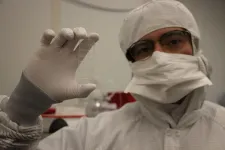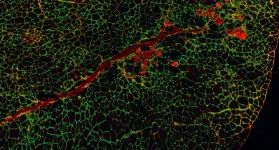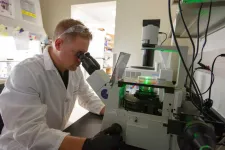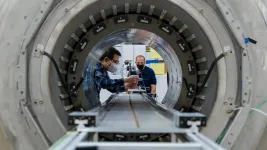Rice, Intel optimize AI training for commodity hardware
CPU algorithm trains deep neural nets up to 15 times faster than top GPU trainers
2021-04-07
(Press-News.org) HOUSTON -- (April 7, 2021) -- Rice University computer scientists have demonstrated artificial intelligence (AI) software that runs on commodity processors and trains deep neural networks 15 times faster than platforms based on graphics processors.
"The cost of training is the actual bottleneck in AI," said Anshumali Shrivastava, an assistant professor of computer science at Rice's Brown School of Engineering. "Companies are spending millions of dollars a week just to train and fine-tune their AI workloads."
Shrivastava and collaborators from Rice and Intel will present research that addresses that bottleneck April 8 at the machine learning systems conference MLSys.
Deep neural networks (DNN) are a powerful form of artificial intelligence that can outperform humans at some tasks. DNN training is typically a series of matrix multiplication operations, an ideal workload for graphics processing units (GPUs), which cost about three times more than general purpose central processing units (CPUs).
"The whole industry is fixated on one kind of improvement -- faster matrix multiplications," Shrivastava said. "Everyone is looking at specialized hardware and architectures to push matrix multiplication. People are now even talking about having specialized hardware-software stacks for specific kinds of deep learning. Instead of taking an expensive algorithm and throwing the whole world of system optimization at it, I'm saying, 'Let's revisit the algorithm.'"
Shrivastava's lab did that in 2019, recasting DNN training as a search problem that could be solved with hash tables. Their "sub-linear deep learning engine" (SLIDE) is specifically designed to run on commodity CPUs, and Shrivastava and collaborators from Intel showed it could outperform GPU-based training when they unveiled it at MLSys 2020.
The study they'll present this week at MLSys 2021 explored whether SLIDE's performance could be improved with vectorization and memory optimization accelerators in modern CPUs.
"Hash table-based acceleration already outperforms GPU, but CPUs are also evolving," said study co-author Shabnam Daghaghi, a Rice graduate student. "We leveraged those innovations to take SLIDE even further, showing that if you aren't fixated on matrix multiplications, you can leverage the power in modern CPUs and train AI models four to 15 times faster than the best specialized hardware alternative."
Study co-author Nicholas Meisburger, a Rice undergraduate, said "CPUs are still the most prevalent hardware in computing. The benefits of making them more appealing for AI workloads cannot be understated."
INFORMATION:
Additional co-authors include Mengnan Zhao of Rice, Sameh Gobriel and Charlie Tai of Intel, and Yong Wu, formerly of Intel and now with Ant Labs.
The research was supported by the National Science Foundation (1652131, 1838177), the Air Force Office of Scientific Research (FA9550-18-1-0152) and the Office of Naval Research.
The MLSys 2021 paper on SLIDE is available at: https://proceedings.mlsys.org/paper/2021/file/3636638817772e42b59d74cff571fbb3-Paper.pdf
High-resolution IMAGES are available for download at:
https://news-network.rice.edu/news/files/2020/03/1209_SLIDE-as028-16-lg.jpg
CAPTION: Anshumali Shrivastava (Photo by Jeff Fitlow/Rice University)
https://news-network.rice.edu/news/files/2021/04/0406_SLIDE2-sd-lg.jpg
CAPTION: Shabnam Daghaghi (Photo courtesy of S. Daghaghi)
https://news-network.rice.edu/news/files/2021/04/0406_SLIDE2-nm-lg.jpg
CAPTION: Nicholas Meisburger (Photo courtesy of N. Meisburger)
Related research from Rice:
Bad news for fake news: Rice research helps combat social media misinformation - Dec. 10, 2020
https://news.rice.edu/2020/12/10/bad-news-for-fake-news-rice-research-helps-combat-social-media-misinformation/
Deep learning rethink overcomes major obstacle in AI industry - March 2, 2020
https://news.rice.edu/2020/03/02/deep-learning-rethink-overcomes-major-obstacle-in-ai-industry/
Rice, Amazon report breakthrough in 'distributed deep learning' - Dec. 9, 2019
https://news.rice.edu/2020/03/02/deep-learning-rethink-overcomes-major-obstacle-in-ai-industry/
Rice U. scientists slash computations for 'deep learning' - June 1, 2017
http://news.rice.edu/2017/06/01/rice-u-scientists-slash-computations-for-deep-learning/
This release can be found online at news.rice.edu.
Follow Rice News and Media Relations via Twitter @RiceUNews.
Located on a 300-acre forested campus in Houston, Rice University is consistently ranked among the nation's top 20 universities by U.S. News & World Report. Rice has highly respected schools of Architecture, Business, Continuing Studies, Engineering, Humanities, Music, Natural Sciences and Social Sciences and is home to the Baker Institute for Public Policy. With 3,978 undergraduates and 3,192 graduate students, Rice's undergraduate student-to-faculty ratio is just under 6-to-1. Its residential college system builds close-knit communities and lifelong friendships, just one reason why Rice is ranked No. 1 for lots of race/class interaction and No. 1 for quality of life by the Princeton Review. Rice is also rated as a best value among private universities by Kiplinger's Personal Finance.
[Attachments] See images for this press release:

ELSE PRESS RELEASES FROM THIS DATE:
2021-04-07
In an article published in the April 8 issue of Nature, the National Institutes of Health's Somatic Cell Gene Editing Consortium provided a detailed update on the progress of their nationwide effort to develop safer and more effective methods to edit the genomes of disease-relevant somatic cells and reduce the burden of disease caused by genetic changes.
Gene editing allows scientists to modify sections of an organism's DNA and is considered a promising treatment for a number of genetic diseases. There have been numerous advances in the laboratory over the last few decades, but there are still many challenges to overcome before gene editing can be widely used in the patient population. Launched in 2018, the Somatic Cell Gene Editing Consortium ...
2021-04-07
A natural brilliant blue coloring has been discovered by an international team of researchers including chemists at the University of California, Davis. The new cyan blue, obtained from red cabbage, could be an alternative to synthetic blue food colorings such as the widely used FD&C Blue No. 1. The work is published April 7 in Science Advances.
"Blue colors are really quite rare in nature - a lot of them are really reds and purples," said Pamela Denish, a graduate student working with Professor Justin Siegel at the UC Davis Department of Chemistry and Innovation Institute for Food and Health.
Having ...
2021-04-07
Scientists have developed a long-sought naturally derived cyan blue colorant sourced from red cabbage anthocyanin pigments that may offer an alternative to the industry standard blue dye, although more testing is needed to determine the compound's safety. The novel colorant, which was developed using an enzyme that converts a range of anthocyanins to one with the ideal wavelength, remains highly stable over time and may also produce better green colors than those derived from existing natural blue colorants. Several research programs around the world are dedicated to the hunt for a natural alternative to FD&C Blue No.1 - a challenging effort given that cyan blue is one of the rarest colors in nature. While previous research has shown that ...
2021-04-07
DURHAM, N.C. -- An interdisciplinary team of scientists at Duke University has developed a highly sensitive and rapid diagnostic test for Ebola virus (EBOV) infection. In monkeys infected with Ebola, this diagnostic, called the D4-assay, proved to be 1000 times more sensitive than the currently approved rapid diagnostic test and capable of detecting the virus a full day earlier than the gold standard polymerase chain reaction (PCR) test.
This work, which appears in Science Translational Medicine on April 7, was done by biomedical engineers, molecular ...
2021-04-07
Progression of Duchenne Muscle Dystrophy (DMD) can be delayed in mice by supplementing their diets with Urolithin A, according to new results reported today. The findings, published in Science Translational Medicine, raise hopes that new treatment options could one-day be developed for DMD, an uncurable genetic condition characterized by progressive muscle degeneration. About 1 in 3,500 boys are born with DMD, which usually develops in childhood and significantly reduces life expectancy.
The new research carried out at the laboratory of Professor Johan Auwerx, ...
2021-04-07
The lungs were for a long time considered to be sterile in health, while in diseases like chronic obstructive pulmonary disease (COPD) failure in immune mechanisms were thought to allow microorganisms to proliferate and persist. New sequencing techniques have shown that several microorganisms reside in the lungs of healthy individuals, as well. Few studies have examined the fungal community in COPD and compared it to healthy controls using such techniques. According to the study findings, the compositions of these environments seem to be unaffected by the use of inhaled steroids.
Lungs have a unique fungal environment
The Bergen COPD Microbiome study (short name "MicroCOPD") is the world's largest single-centre study on the fungal community in ...
2021-04-07
JUPITER, FL - People with Crohn's disease are typically treated with powerful anti-inflammatory medications that act throughout their body, not just in their digestive tract, creating the potential for unintended, and often serious, side effects. New research from the lab of Mark Sundrud, PhD, at Scripps Research, Florida suggests a more targeted treatment approach is possible.
Crohn's disease develops from chronic inflammation in the digestive tract, often the small intestine. More than half a million people in the United States live with the disease, which can be debilitating and require repetitive surgeries to remove irreversibly damaged intestinal tissue.
Writing in the journal Nature on April 7, Sundrud's team finds that certain immune cells ...
2021-04-07
Tracking carbon dioxide levels indoors is an inexpensive and powerful way to monitor the risk of people getting COVID-19, according to new research from the Cooperative Institute for Research in Environmental Sciences (CIRES) and the University of Colorado Boulder. In any given indoor environment, when excess CO2 levels double, the risk of transmission also roughly doubles, two scientists reported this week in Environmental Science & Technology Letters.
The chemists relied on a simple fact already put to use by other researchers more than a decade ago: Infectious people exhale ...
2021-04-07
Harmful algal blooms (HABs) occur in all 50 U.S. states and many produce toxins that cause illness or death in humans and commercially important species. However, attempts to place a more exact dollar value on the full range of these impacts often vary widely in their methods and level of detail, which hinders understanding of the scale of their socio-economic effects.
In order to improve and harmonize estimates of HABs impacts nationwide, the National Oceanic and Atmospheric Administration (NOAA) National Center for Coastal Ocean Science (NCCOS) and the U.S. National Office for Harmful Algal Blooms at the Woods Hole Oceanographic Institution (WHOI) convened a workshop led by WHOI Oceanographer ...
2021-04-07
Scientists are testing our fundamental understanding of the universe, and there's much more to discover.
What do touch screens, radiation therapy and shrink wrap have in common? They were all made possible by particle physics research. Discoveries of how the universe works at the smallest scale often lead to huge advances in technology we use every day.
Scientists from the U.S. Department of Energy's (DOE) Argonne National Laboratory and Fermi National Accelerator Laboratory, along with collaborators from 46 other institutions and seven countries, are conducting an experiment to put our current understanding of the universe to the test. The first result points to the existence of undiscovered particles or forces. This new physics could help explain long-standing ...
LAST 30 PRESS RELEASES:
[Press-News.org] Rice, Intel optimize AI training for commodity hardware
CPU algorithm trains deep neural nets up to 15 times faster than top GPU trainers






